|
|
| |
ITALY
ROME
LANDMARKS, MUSEUMS AND GALLERIES
ART CENTER ACEA: MONTEMATRINI – Over 400 sculptures are permanently displayed in one of Rome’s first power plants, and juxtaposition of ancient art and industrial architecture is truly spectacular. Open Tues.-Sun. 9:30 a.m.-7 p.m. Tickets: Euro - 4,20, reduced rate for students Euro – 2,60, 18 and under and over 65 free. Viale Ostiense, 106. Tel. 065748030.
CAPITOLINE MUSEUMS – One of the most important Roman museums housing important works of Ancient Rome as well as great works by Bernini and Caravaggio. Open Tuesday-Sunday 9 a.m.-8 p.m. P.zza del Campidoglio. Tel. 0639967800. Euro – 6,20.
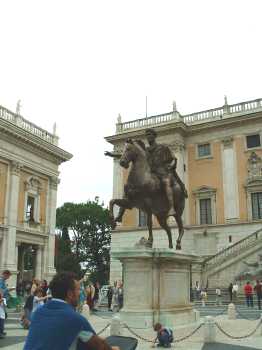 Photo PKG
THE COLLOSSEUM – The Flavian Amphitheatre, symbol of Rome, built in A.D. 72. The 50,000 capacity amphitheatre originally had a sail-like roof covering. Until October 28 opens every day from 9 a.m. to 7:30 p.m. After October 28 opens from 9 a.m. to 4:30 p.m. Tickets Euro – 8 including admissions to the Palatine. Piazza del Colosseo.
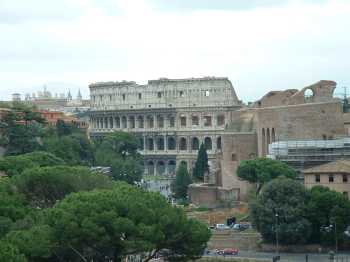 Photo PKG
DOMUS AUREA – Neros’s extraordinary Golden House, near the Colosseum, has finally been opened to the public after 18 years and 8 million Euros of restoration works. Open from every day 9 a.m. to 8 p.m. Closed Tues. Reservations one day in advance are obligatory: 0639967700. Euro – 6,50. Viale della Domus Aurea.
THE FORUM – The heart of Ancient Rome. See Septimius Severus’ Arch, the Temple of Castor and Pollux, the House of the Vestal Virgins, the Basilica Emilia and the Temple of Vesta. Open every day from 9 a.m. to 7:30 p.m. Free entry to the Forum Largo Romolo and the Remo. Tel. 066990110.
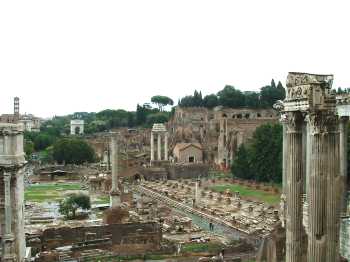 Photo PKG
GALLERIA BORGHESE - Built in 1613 to hold Cardinal Scipione Borghese’s collection of art, including works by G.L. Bernini, Correggio, Piazza Scipione Borghese, 5. By reservation only: Tel. 0632810. Open from Tues. to Sun. from 9 a.m. to 7 p.m. Euro – 8,50. Closed Mon.
GALLERIA DORIA PAMPHILI – This gallery has a rich collection of major works by Italian artists from the 1500’s and the 1600’s: Titian, Raphael, Correggio, Caravaggio, Guercino, Reni, Bernini, Velazquez, Pizza del Collegio Romano, 1A. Open 10 a.m.-5 p.m. Closed Thurs. Tickets: Euro – 7,30 (reduced Euro – 5,70). Tel. 066794365.
G.N.A.M GALLERY OF MODERN ARTS – The largest Italian collection of art from the 19th and 20th centuries, with works by Balla, Boccioni, De Chirico, Modigliani and others. Among foreign artists there are works by Van Gogh, Klimt, Klee, Kandinsky, and Miro Via delle Belle Arti, 131. Open Tues.-Sun. 8:30 a.m.-7:30 p.m. Tickets: Euro – 6,50. Tel. 063234000.
MACRO – This contemporary art museum of Rome is located in the former Peroni beer factory. It also has a temporary exhibition space (Mattatoio) at Piazza Orazio Giustiniani, 4 (Map B7). Via Reggio Emilia, 54. Open Tues. to Sat., 9 a.m. to 7 p.m. and on Sundays from 10 a.m. to 2 p.m. Admissions Euro – 5,20 and free of charge under 18 and over 65. Tel. 0667107900.
NATIONAL MUSEUM OF CASTEL SANT’ANGELO – Emperor Hadrian’s mausoleum constructed in A.D. 134, transformed into a fortress 150 years later, remained as such until the beginning of the 19th century. Open Tues.-Sun. 9 a.m.-8 p.m. Tickets: Euro – 5. Giardini di Castello. (Piazza Adriana).
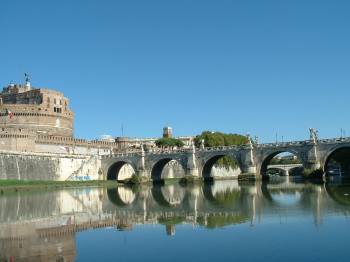 Photo PKG
OSTIA ANTICA – 16 miles southwest of Rome, Ostia was Rome’s main commercial port and a military base defending the coastline and the mouth of the Tiber. The city is remarkably well-preserved, and gives an excellent picture of life under the Roman Empire. “Caffatteria degli Scavi” on site. Entrance: Euro – 4. Viale dei Romagnoli, 717. Tel. 0656358036. Take metro B line, get off at Magliana, then take train to Ostia Antica.
PALAZZO ALTEMPS – The Renaissance Palazzo Altemps was squired and restored by Rome archaeological authority, and houses a collection of ancient Roman statues belonging to great Roman families. Open Tues.-Sun. 9 a.m.-7:45 p.m.; ticket office closes one hour earlier. Tickets: Euro – 5. Piazza Sant’Apollinare, 46/48.
PALLAZZO MASSIMO (MUSEO NAZIONALE ROMANO) – Important public art collection comprised of Imperial busts, Roman statues, mosaics, sarcophagi and breathtaking frescoes. Open Tuesdays to Sundays from 9 a.m. to 7:45 p.m.; ticket office closes one hour earlier. Tickets: Euro – 5,16. Largo di Villa Peretti, 1. Tel. 064815576.
THE PANTHEON – The best preserved and one of the most famous Roman monuments, it was constructed by Agrippa in 27 B.C. and rebuilt by Hadrian in A.D. 117-125. in A.D. 608 it was transformed into a Christian Church. It contains the tombs of the great painter Raphael and Vittorio Emanuela. Pizza della Rotonda.
SAINT PETER’S – The largest, most famous and magnificent basilica in the world. Within it lie works of art (including Michelangelo’s “Pieta”) covering almost 2,000 years of history. The Basilica was originally built where the Apostle Saint Peter was believed to have been buried. The current basilica was inaugurated in 1626 and only later the square in front was planned and completed with its colonnade by Bernini. Open 7 a.m.-7 p.m. Climb up the dome, entrance from the portico: opens 8 a.m.-6 p.m. Tickets: Euro 3,10.
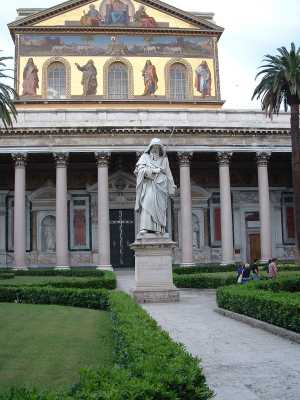 Photo PKG
VATICAN MUSEUM / SISTENE CHAPEL – Explore the Vatican Museums’ collection of Etruscan, Roman, Renaissance and Baroque art, works by Michelangelo, Raphael, Caravaggio and Canova as well as the awe-inspiring Sistine Chapel (suggestion: arrive early in the morning, and go directly to the chapel). Open from Monday to Friday from 8:45 a.m. to 1:35 p.m., Saturday from 8:45 a.m. to 1:35 p.m. (entrance until 12:45 p.m.). Tickets: Euro – 10 (Open the last Sunday of every month, entrance free) Viale del Vaticano. Tel. 0669884947.
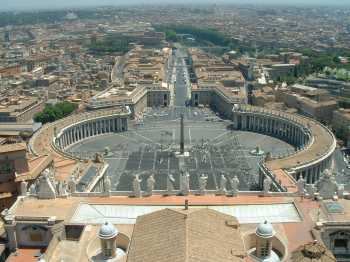 Photo BPG
VILLA BORGHESE – The most beautiful public garden in Rome, created by Cardinal Borghese at the beginning of the 17th century. Two of the nicer areas of the park are the Giardino del Lago, where you can rent boats, and Piazza Siena, where international equestrian events take place each spring. Just beyond the park is the Bioparco (Rome’s Liberty-style zoo), the Borghese Gallery, and the National Gallery of Modern Arts. The park is open from dawn till duck every day. Map C3.
| |
|
Festivals & Events
Vinum Bonum
This is a very special period in Valley Veneggia just south of Bolzano and just north of the upper tip of Lake Garda. For the entire month of August there are musical concerts held in a variety of the 27 wine-gowing 'cantinas' in the valley selected by a governing board for the high quality of the wines they produce. The tastings all begin at 4:30 in the afternoon and conclude at 7:00 PM and are only held on Tuesdays, Thursdays and Fridays.
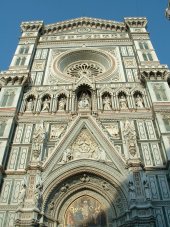 St. Maria del Fiore, Florence
Photo: BPG
International Piano Festival - Amalfi
July and August
The Chiostro del Paradiso is the setting for concerts by Italian and foreign pianists who alternate playing every Friday.
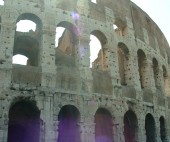 The Colosseum, Rome
Photo: BPG
MUSICAL WEEKS
Siena
August
Accademia Musicale Chigiana
Via di Città 89 - 53100 Siena
Tel. 39 0577 46152
Fax 39 0577 288124
Spoleto
June - July
Associazione Festival dei Due Mondi
Piazza Duomo 8 - 06049 Spoleto
Tel. 39 0743 220320 or 45028 or 40619
Fax 39 0743 220321
e-mail: spoletofestival@krenet.it
Torre del Lago Festival Pucciniano
August
Torre del Lago Puccini
Piazzale Belvedere 4 - 55048 Viareggio (Lucca)
Tel. 39 0584 350562
Fax 39 0584 350277 or 350562
Umbria Umbria Jazz
July
"Associazione Umbria Jazz"
P.O. Box 228 - 06100 Perugia
Tel. 39 075 62432
Fax 39 075 5730053
Viterbo Baroque Music Festival
August
Palazzo Santoro - Piazza Verdi 4/A 01100 Viterbo
Tel.39 0761 326666
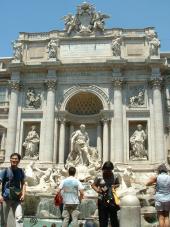 The Trevi Fountain, Rome
Photo: BPG
Ivrea Carnival
Early January
(lasts for 5 days)
In 2001 the carnival celebrated its 194th edition, but the area had started celebrating the events as early as the 1600s. The fight for liberty, when the men of Ivrea "expelled" the Marquis of Monferrato, is recreated with the Battles of the Oranges, which substitute stones. To make it fun there are several orange throwing "teams", all sporting colorful uniforms. The Carnival also has a lot of parties, food events and music.
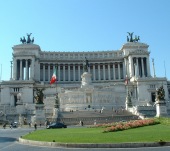 Vittorio Emanuele Monument, Rome
Photo: BPG
San Gennaro - Naples
September
San Gennaro, patron saint and protector of Napoli, stands for many as a symbol of the city itself, and his festival is one of the most passionately celebrated in all of Italy.
The festival ideally culminates in the miracle of the liquefaction of the blood of San Gennaro, which takes place every year more or less on the date of the festival. Many accept the divine nature of the event, and it is incontestable that the blood liquefies, but experts obviously differ on why or how this happens.
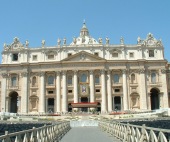 St. Peter's Basilica, Rome
Photo: BPG
Easter Sunday Florence
The annual 'holy fire' during Holy Week, is started with historical shards of the Holy Sepulchre, and is lit in the Church of SS Apostoli and transported to the Duomo, where the archbishop of the city lights the sacred 'Colombina' rocket with it during the Easter Mass. The rocket travels out of the Duomo along a wire, sets fire to the huge array of fireworks attached to the ICARRO and returns back into the church the way it came.
The celebration of the ceremony still bears a strong resemblance to the way in which it has been celebrated for centuries. On the morning of the day the Carro, pulled by two white oxen, leaves from Via del Prato for the Piazza del Duomo, accompanied by costumed revellers and various city officials and clerical representatives.
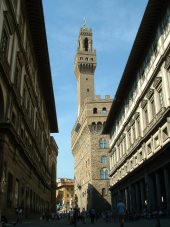 Palazzo Vecchio, Florence
Photo: BPG
The Palio delle Contrade,
Siena
July
A banner, decorated with an image of the Virgin Mary, is presented to the winner of a horse race around the Siena's Piazza del Campo. Competitors come from each one of the 17 districts of the city.
The race consists of bareback riders making three circuits of the main square and is over in 90 seconds. But it is preceded by 5 hours of flag throwing acrobatics around the main square.
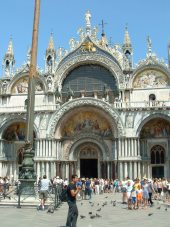 St. Marco Basilica, Venice
Photo: BPG
Viareggio
February - March
Every year The Viareggio Carnival is the most spectacular in Italy, and is known world-wide. The people of Viareggio begin preparing the huge papier-maché puppets in hangar-like buildings by the sea. The figures satirise public and political figures; making them and setting them atop the floats requires considerable technical skill as well as creativity and imagination.
The voluminous floats parade around Viareggio competing for the finest float award from 2.30pm until 9pm on the following dates: 11, 18, 25, 27 Feb and 4 March, each one carrying about 200 people in costume, as well as the huge moving, Trojan horse-like puppets, which hold people inside to manoeuvre the weights, counter-weights and levers that prevent them from toppling over.
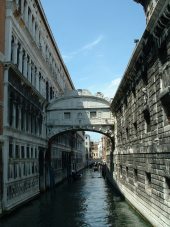 The Bridge of Sighs, Venice
Photo: BPG
|
|
|